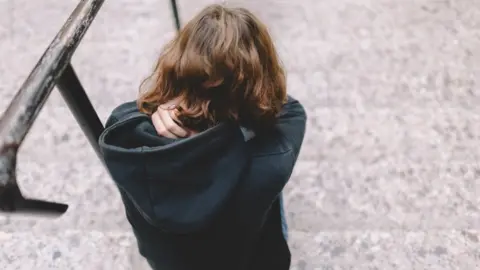Fifth of 14-year-old girls in UK 'have self-harmed'
More than a fifth of 14-year-old girls in the UK said they had self-harmed, a report suggests.
A survey of 11,000 children found 22% of the girls and 9% of the boys said they had hurt themselves on purpose in the year prior to the questionnaire.
Rates of self-harm were worst (46%) among those who were attracted to people of the same or both genders.
The Children's Society report said gender stereotypes and worries about looks were contributing to unhappiness.
The self-harm statistics are included in the charity's annual Good Childhood Report, which examines the state of children's wellbeing in the UK.
The data on self-harm was analysed by The Children's Society after being collected in 2015 in the Millennium Cohort Study, a continuing research project following the lives of 19,000 children born in the UK between 2000 and 2001.
More than 11,000 of these children answered a questionnaire about whether they had hurt themselves on purpose in any way in the past year. Out of the 5,624 girls who responded, 1,237 said they had self-harmed.
Self-harm is when people hurt themselves as a way of dealing with difficult feelings, painful memories or overwhelming situations and experiences.
It can include everything from punching or hitting to cutting or burning.
Based on the figures, The Children's Society estimates that 109,000 children aged 14 may have self-harmed across the UK during the 12-month period in 2015 - 76,000 girls and 33,000 boys.
It follows NHS data released this month that showed the number of admissions to hospital of girls aged 18 and under for self-harm had almost doubled in two decades, from 7,327 in 1997 to 13,463 in 2017.
The NSPCC says common reasons for self-harming include:
- depression
- bullying
- pressure at school
- emotional abuse
- grieving
- having relationship problems with family or friends
Matthew Reed, chief executive at The Children's Society, said: "It is deeply worrying that so many children are unhappy to the extent that they are self-harming.
"Worries about how they look are a big issue, especially for girls, but this report shows other factors such as how they feel about their sexuality and gender stereotypes may be linked to their unhappiness."

'It became an obsession'
 Getty Images
Getty ImagesAn 18-year-old woman who used to self-harm said she had started aged 12 in an attempt to deal with painful or overwhelming feelings.
She said: "It quickly became an obsession.
"My self-harm problem caused me to lie to those who cared about me, time and time again, as I pushed away the people around me."
Self-harm was often "romanticised" on social media, which drew in the most vulnerable people, she said.
But professional support had helped her to stop and develop healthy ways of coping with her problems.
"Recovery has changed my life. I am a person I never thought I could be with a bright future ahead of me - yet I know others who haven't received the help I did and are still battling.
"To those struggling, please talk to people you can trust - you can and will get through this."

Gender stereotypes
A separate survey of 10- to 17-year-olds and their parents across 2,000 households, also included in The Children's Society report, found the children were unhappiest with school and their appearance.
This research also suggests that boys and girls are often harmed by gender stereotypes.
Those who felt boys should be tough and girls should have nice clothes were least happy with life.
The report also suggests happy family relationships are the biggest positive influence on children's wellbeing.
The Children's Society called on the government to make it a requirement for all secondary schools to offer access to a counsellor and have their mental health services assessed in Ofsted inspections.
The Department of Health said it is investing an extra £300m to provide more mental health help in schools - including trained staff.
A spokesperson said: "We've extended our pilot scheme to deliver training in 20 more areas of the country this year to improve links between 1,200 schools and their mental health services."
The government added it will announce more on how it can improve mental health as part of its long-term plan for the NHS later this year.
Emma Thomas, chief executive of Young Minds, said: "Difficult experiences in childhood, like growing up in poverty or experiencing discrimination, can have a huge impact on mental health - but there are also new pressures that have emerged in recent years.
"The education system now places a greater emphasis than ever on exam results, while the rise of social media can make problems like bullying or body image issues more intense than they were in the past."
The Royal College of Paediatrics and Child Health said mental health was "one of the biggest health epidemics of our time" and strongly linked to social disadvantage.
A spokesman added: "This country's mental health crisis is not going to go away overnight but with appropriate action from government there is hope that fewer children will have mental health worries and be happier with their life as a result."

What adults can do to help a child who is self-harming
- Show you understand
- Talk it over
- Discover the triggers
- Build their confidence
- Show you trust them
- Choose who you tell carefully
- Help them find new ways to cope
How to spot warning signs
Look for physical signs such as cuts, bruises, burns and bald patches from pulling out hair. These are commonly on the head, wrists, arms, thighs and chest.
The emotional signs are harder to spot:
- depression
- tearfulness and low motivation
- becoming withdrawn and isolated, for example wanting to be alone in their bedroom for long periods
- sudden weight loss or gain
- low self-esteem and self-blame
- drinking or taking drugs
Source: NSPCC
For further information about self-harm, click here, or visit:

